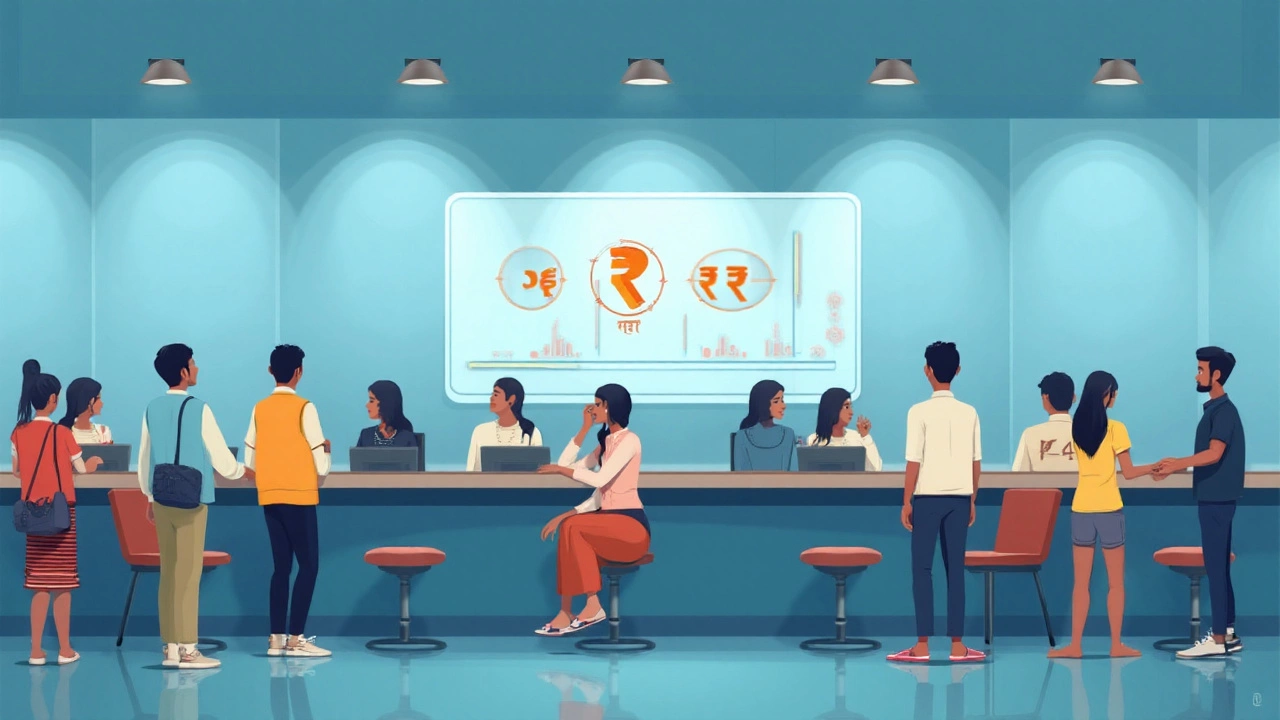 Aug, 8 2025
Aug, 8 2025
Ever waited for a refund and checked your account five times a day like it was the lottery? Don’t worry, you’re not alone. People expect the money to drop in as soon as a refund is approved, but the reality is way less instant. The day a refund lands in your bank account depends on a bunch of things—bank processes, the source of the refund, and even what day of the week it is. No one wants to keep refreshing the app and playing detective. So, here’s the real story on refund deposit days, why you might see delays, and how you can make sure your money doesn’t get held up.
How Banks Process Refund Deposits
Let’s clear up this big mystery: Banks don’t actually sit on your refund just for fun. When a company sends your refund, especially online retailers or government agencies, it triggers an electronic transfer known as an ACH (Automated Clearing House) transaction. ACH is the backbone of most refunds, salary direct deposits, even your regular payments. It isn’t instantaneous, though—it works in batches, and different banks process those batches at different times of the day.
Think of it this way: If you get a refund sent on a Friday evening, your bank might not even see the money until Monday morning. Why? Because most banks only process ACH transfers on business days—weekends and public holidays are like a hard “no entry” sign for electronic transactions. While a few online-only banks march to their own beat, the big names—SBI, HDFC, ICICI, and such—stick to the standard weekday schedule.
The type of refund matters too. If you’re waiting for a tax refund, central government agencies send out batches and banks process them as they arrive. A refund from Amazon or Flipkart? That’s up to the payment gateway and your card network. Some banks process these within a day or two; others drag their feet for 3-5 business days, maybe more if there was a holiday in between.
| Refund Source | Usual Processing Time | Fastest Arrival Day |
|---|---|---|
| Online Retailer (card payment) | 3-5 business days | Wednesday - Friday |
| UPI/Wallet Refunds | Instant to 24 hours | Any weekday |
| Income Tax Refund | 7-10 business days | Tuesday - Thursday |
| Bank Fee Reversal | 1-3 business days | Wednesday - Friday |
Most banks post incoming ACH transactions overnight, once a day, in the early morning hours—typically around 4-7 AM local time. That’s why you might wake up and find your refund has magically appeared, even if you gave up hope the night before. But nothing posts on weekends, and national holidays create a backlog, so your best bet for a deposit is usually between Tuesday and Friday. Mondays often see catch-up processing, but the previous day’s (Sunday) deposits won’t show until Tuesday. Friday-batch refunds may not post before the weekend, leaving you hanging until Monday or Tuesday next week.
Why Refund Days Vary: What to Expect and Watch Out For
There’s an odd sense of hope attached to Fridays, right? Maybe it’s payday, or maybe it’s wishful thinking that your refund will show up just in time for weekend plans. Trouble is, Friday is actually the riskiest day to expect a refund to post. Banking operations wrap up early, systems lock down for the weekend, and if there’s any hiccup, you’re stuck until Monday. Banks in India—both private and public—aren’t even allowed to process most kinds of deposits after cutoff times on Fridays. Even international refunds face delays, as most SWIFT and wire transfers only resume batches on the next business day.
Another thing to know—your bank’s software isn’t flawless. Sometimes, a refund hits their system but doesn’t show up in your account right away. Smaller banks may process incoming deposits just once a day, while the larger players might do it in two or three scheduled runs, especially if they handle excess volumes. Internet-banking or mobile-banking notifications are synced with updates—so you could receive a text several hours after the money actually lands (annoying, right?).
It’s not just banks—payment gateways and card networks like VISA, Mastercard, and RuPay add an extra layer of delay. Card-based refunds take more time since they route through merchant banks. UPI and wallet refunds are quicker, almost always same-day, but when money flows back to an actual bank account, it may get caught in the regular banking cutoffs. You might have noticed that Paytm, PhonePe, or Google Pay refunds land faster than, say, a credit card reversal. It’s because wallets don’t rely on batched settlement as much as core banks do.
Let’s pull back the curtain. Banks don’t make exceptions, even for big-ticket refunds. If a company tells you “3-5 business days,” that’s real. Banks can only credit your account when your money (and the right code) actually shows up their end. But if you don’t see the funds after 5 working days, that’s when it’s time to call customer care both at the refunder’s end and your own bank. Sometimes, a refund can get lost because of a mismatch in account numbers, IFSC codes, or just a typo. Always double-check the details before closing the chat window with a support agent.
A pro tip: Avoid banking holidays and big sale days when requesting refunds. During festive seasons, banks face additional loads—millions of refunds, reversals, and cashbacks process together, which means yours is part of a massive queue. Refunds announced on a holiday or just before a public holiday can get pushed back even more. Websites might promise “within 48 hours,” but real-world banking never promises weekend miracles.

How Refund Schedules Work for Different Banks and Payment Types
Timing a refund? Each bank and payment type dances to its own tune. For public sector banks—like SBI, PNB, Bank of Baroda—batch processing tends to happen once a day, between 5-7 AM, and skips weekends. If you bank with a private one like HDFC, ICICI, Axis, they sometimes process in two batches (morning and late afternoon). Digital-first banks like Kotak811 or IDFC FIRST are getting faster but are still limited by RBI batch timings, which are tightly regulated. RBI and NPCI have to balance clearing loads across millions of accounts. If things get clogged, speed drops.
Credit card refunds are an entirely different beast. These don’t work like regular bank refunds at all. When you cancel a credit-card transaction, the merchant triggers a reversal to your card account, but you won’t see it with your available balance right away. It first “settles” with the merchant’s bank before getting remitted to your card, which is why you get texts about “credit adjustments” a few days before the money is spendable. On average, India’s card refund timeline is 5-7 working days.
UPI refunds cut out tons of delay. Since UPI operates 24/7/365, any refund—whether from a merchant or peer-to-peer transfer—often hits instantly or within minutes. If you’re refunding back to your debit card linked to your UPI ID, you’re lucky. But if the refund routes back via NEFT or IMPS, you might face the same “next business day” bottleneck, especially if the refund was issued after banking business hours.
Here’s a look at the processing cutoffs for a few major Indian banks for incoming credits (as of 2024):
| Bank Name | Main Processing Window | Accepted Refund Types |
|---|---|---|
| SBI | 5-7 AM (once per day) | ACH, NEFT, IMPS, Card |
| HDFC | 6-8 AM, 2-4 PM | ACH, NEFT, UPI, Card |
| ICICI | 6-7 AM, 2-3 PM | ACH, IMPS, UPI, Card |
| Kotak | 6-8 AM (once per day) | ACH, NEFT, UPI |
So, what day should you expect most refunds? Wednesday and Thursday are the sweet spots. By midweek, banks have cleared up weekend lags, and Friday isn’t looming to kick your refund into next week. As a rule, avoid counting on Monday mornings. Banks sometimes are still clearing Saturday’s overflow. If your refund was “approved” by a merchant on a Saturday, don’t get your hopes up till Tuesday or Wednesday.
Tips to Track, Speed Up, and Secure Your Refunds
Don’t just sit tight and hope for the best—there are ways to track, speed up, and even secure your refunds so you’re not left hanging. First off, always cross-verify if the money was already refunded from the sender’s side. Many companies shoot off an email or push notification when your refund is processed. Grab any transaction reference or UTR (Unique Transaction Reference) number—they’re gold when tracking with your bank.
You can check the refund status in real-time via net banking or app, but sometimes those show “expected date” instead of “actual posted date.” Got a UPI refund? Fire up BHIM or your app of choice and search for the UTR or transaction ID. For card refunds, log into your card portal and spot “credit reversals” or “refund” lines—don’t rely on SMS alone.
Here are some steps that help speed up the process or at least make the wait less confusing:
- Always confirm your refund destination—wrong account number, IFSC, or phone number means your money may go missing forever.
- If you don’t see the refund by the promised day, raise a ticket with the company directly—the clock starts ticking on their promise only once they process it, not when you request it.
- Use UPI or instant wallets where possible—refunds on these platforms are quicker and easier to track.
- For larger refunds (like tax returns or loan closures), keep a screenshot of the refund advice, unique reference IDs, and transaction date.
- If you think your refund got stuck between two banks, call both banks—it’s often the only way to find the actual culprit.
- Bank not responding? Use the RBI Ombudsman or file a consumer complaint if it’s been more than 7 working days without any update.
Don’t forget—if a company tells you “processed,” this only means their system released the funds. The bank still has to do its job to actually drop the money into your account—patience pays, but records save you from pain.
Here’s a quirky stat: A survey by a major digital wallet found that the average Indian waits 4.7 days for an e-commerce refund to show up, but only 1.5 days for a UPI-based merchant refund. Banks admit that downtime, public holidays, or technical glitches cause 15-20% of refunds to come “later than expected” but most clear within 3 business days when no holidays are involved. Now you know why that irritating delay isn’t always your bank’s fault.
Last piece of advice—schedule big refunds for the middle of the week, use accounts with digital-first banks, and always, always double-check the refund method to avoid those heart-stopping “where’s my money?” moments. And remember, refund deposit day isn’t magic—just good old batch processing. Waiting might feel like forever, but it all comes down to the clockwork of the banking system.